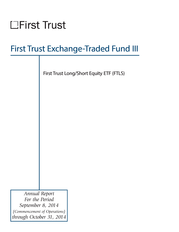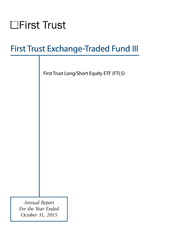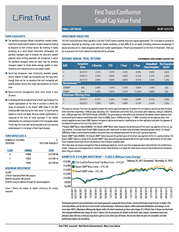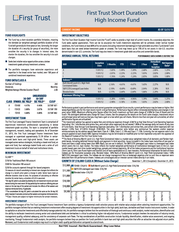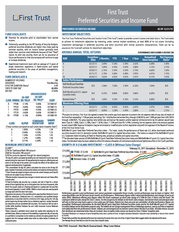Description
First Trust High Income Long/Short Fund (FSD)
Average Annual Returns (as of 2/29/2016)5
Period
Industry Breakdown (as of 1/31/2016)6
Share Price
NAV
3 Years
-2.25%
1.19%
5 Years
2.07%
3.85%
Inception to Date
1.41%
4.97%
Credit Quality Breakdown for Bonds (as of 1/31/2016)6
Credit Quality
BBB- and above
BB
B
NR
CCC+ and below
Percent
15.51%
48.25%
26.39%
0.53%
9.32%
The credit quality and ratings information presented above reflect the
ratings assigned by one or more nationally recognized statistical rating
organizations (NRSROs), including Standard & Poor's Rating Group, a
division of the McGraw Hill Companies, Inc., Moody's Investors Service,
Inc., Fitch Ratings, or a comparably rated NRSRO. For situations in which
a security is rated by more than one NRSRO and the ratings are not
equivalent, the highest ratings are used. Sub-investment grade ratings are
those rated BB+/Ba1 or lower. Investment grade ratings are those rated
BBB-/Baa3 or higher.
The credit ratings shown relate to the credit worthiness of the issuers of the underlying securities in the Fund, and not to the Fund or its shares. Credit ratings are subject to change. Percentages of credit quality are based on the Fixed-Income Investments Long positions only; Short positions are excluded. Industry Basic Industry Healthcare Capital Goods Telecommunications Automotive Banking Media Leisure Energy Insurance Technology & Electronics Transportation Financial Services Consumer Goods Services Commercial Mortgage-Backed Securities Utility Retail Collateralized Mortgage Obligations Asset Backed Real Estate Percent 12.13% 10.53% 9.27% 7.59% 7.02% 6.69% 6.33% 5.49% 5.22% 5.19% 5.09% 4.67% 4.54% 3.38% 3.35% 1.18% 0.84% 0.67% 0.59% 0.20% 0.03% Footnotes Investment return and market value of an investment in the fund will fluctuate. Shares, when sold, may be worth more or less than their original cost. The fund invests in non-investment grade debt instruments, commonly referred to as "high-yield securities".
High yield securities are subject to greater market fluctuations and risk of loss than securities with higher ratings. Lower-quality debt tends to be less liquid than higher-quality debt. The debt securities in which the fund invests are subject to certain risks, including issuer risk, reinvestment risk, prepayment risk, credit risk, and interest rate risk. Issuer risk is the risk that the value of fixed-income securities may decline for a number of reasons which directly relate to the issuer.
Reinvestment risk is the risk that income from the fund's portfolio will decline if the fund invests the proceeds from matured, traded or called bonds at market interest rates that are below the fund portfolio's current earnings rate. Prepayment risk is the risk that, upon a prepayment, the actual outstanding debt on which the fund derives interest income will be reduced. Credit risk is the risk that an issuer of a security will be unable or unwilling to make dividend, interest and/or principal payments when due and that the value of a security may decline as a result.
Interest rate risk is the risk that fixed-income securities will decline in value because of changes in market interest rates. In times of unusual or adverse market, economic, regulatory or political conditions, the fund may not be able, fully or partially, to implement its short selling strategy. Short selling creates special risks which could result in increased volatility of returns and may result in greater gains or greater losses. The fund invests in securities of non-U.S. issuers which are subject to higher volatility than securities of U.S.
issuers. Because the fund invests in non-U.S. securities, you may lose money if the local currency of a nonU.S.
market depreciates against the U.S. dollar. The risks of investing in the fund are spelled out in the prospectus, shareholder report and other regulatory filings. Not FDIC Insured • Not Bank Guaranteed • May Lose Value 1 The NAV represents the fund's net assets (assets less liabilities) divided by the fund's common shares outstanding. 2 Fund shares are purchased and sold on an exchange at their share price rather than net asset value (NAV), which may cause the shares to trade at a price greater than NAV (premium) or less than NAV (discount). 3 Most recent distribution paid or declared to today's date. Subject to change in the future.
There is no guarantee that the fund will declare dividends. 4 Risk Considerations Distribution rates are calculated by annualizing the most recent distribution paid or declared through today's date and then dividing by the most recent market price. The distribution consists of the sum of net investment income, net realized short-term capital gains, net realized long-term capital gains, and return of capital. Distribution rates may vary.
Any distribution adjustment will not be reflected until after the declaration date for the next distribution. See the fund's 19a-1 Notices, if any, located under the "News & Literature" section of the website for estimates of distribution sources. Final determination of the source and tax status of all distributions paid in the current year will be made after year-end. 5 Total return is the combination of reinvested dividend income and reinvested capital gains distributions, at prices obtained by the Dividend Reinvestment Plan, if any, and changes in the NAV and Share Price. The NAV total return takes into account the fund's total annual expenses and does not reflect sales load.
Past performance is not indicative of future results. 6 Market value information used in calculating the percentages is based upon trade date plus one recording of transactions, which can differ from regulatory financial reports (Forms N-CSR and N-Q) that are based on trade date recording of security transactions. Holdings are subject to change. .
The credit ratings shown relate to the credit worthiness of the issuers of the underlying securities in the Fund, and not to the Fund or its shares. Credit ratings are subject to change. Percentages of credit quality are based on the Fixed-Income Investments Long positions only; Short positions are excluded. Industry Basic Industry Healthcare Capital Goods Telecommunications Automotive Banking Media Leisure Energy Insurance Technology & Electronics Transportation Financial Services Consumer Goods Services Commercial Mortgage-Backed Securities Utility Retail Collateralized Mortgage Obligations Asset Backed Real Estate Percent 12.13% 10.53% 9.27% 7.59% 7.02% 6.69% 6.33% 5.49% 5.22% 5.19% 5.09% 4.67% 4.54% 3.38% 3.35% 1.18% 0.84% 0.67% 0.59% 0.20% 0.03% Footnotes Investment return and market value of an investment in the fund will fluctuate. Shares, when sold, may be worth more or less than their original cost. The fund invests in non-investment grade debt instruments, commonly referred to as "high-yield securities".
High yield securities are subject to greater market fluctuations and risk of loss than securities with higher ratings. Lower-quality debt tends to be less liquid than higher-quality debt. The debt securities in which the fund invests are subject to certain risks, including issuer risk, reinvestment risk, prepayment risk, credit risk, and interest rate risk. Issuer risk is the risk that the value of fixed-income securities may decline for a number of reasons which directly relate to the issuer.
Reinvestment risk is the risk that income from the fund's portfolio will decline if the fund invests the proceeds from matured, traded or called bonds at market interest rates that are below the fund portfolio's current earnings rate. Prepayment risk is the risk that, upon a prepayment, the actual outstanding debt on which the fund derives interest income will be reduced. Credit risk is the risk that an issuer of a security will be unable or unwilling to make dividend, interest and/or principal payments when due and that the value of a security may decline as a result.
Interest rate risk is the risk that fixed-income securities will decline in value because of changes in market interest rates. In times of unusual or adverse market, economic, regulatory or political conditions, the fund may not be able, fully or partially, to implement its short selling strategy. Short selling creates special risks which could result in increased volatility of returns and may result in greater gains or greater losses. The fund invests in securities of non-U.S. issuers which are subject to higher volatility than securities of U.S.
issuers. Because the fund invests in non-U.S. securities, you may lose money if the local currency of a nonU.S.
market depreciates against the U.S. dollar. The risks of investing in the fund are spelled out in the prospectus, shareholder report and other regulatory filings. Not FDIC Insured • Not Bank Guaranteed • May Lose Value 1 The NAV represents the fund's net assets (assets less liabilities) divided by the fund's common shares outstanding. 2 Fund shares are purchased and sold on an exchange at their share price rather than net asset value (NAV), which may cause the shares to trade at a price greater than NAV (premium) or less than NAV (discount). 3 Most recent distribution paid or declared to today's date. Subject to change in the future.
There is no guarantee that the fund will declare dividends. 4 Risk Considerations Distribution rates are calculated by annualizing the most recent distribution paid or declared through today's date and then dividing by the most recent market price. The distribution consists of the sum of net investment income, net realized short-term capital gains, net realized long-term capital gains, and return of capital. Distribution rates may vary.
Any distribution adjustment will not be reflected until after the declaration date for the next distribution. See the fund's 19a-1 Notices, if any, located under the "News & Literature" section of the website for estimates of distribution sources. Final determination of the source and tax status of all distributions paid in the current year will be made after year-end. 5 Total return is the combination of reinvested dividend income and reinvested capital gains distributions, at prices obtained by the Dividend Reinvestment Plan, if any, and changes in the NAV and Share Price. The NAV total return takes into account the fund's total annual expenses and does not reflect sales load.
Past performance is not indicative of future results. 6 Market value information used in calculating the percentages is based upon trade date plus one recording of transactions, which can differ from regulatory financial reports (Forms N-CSR and N-Q) that are based on trade date recording of security transactions. Holdings are subject to change. .

